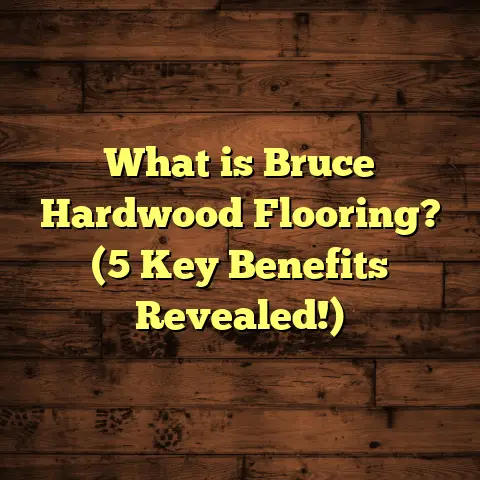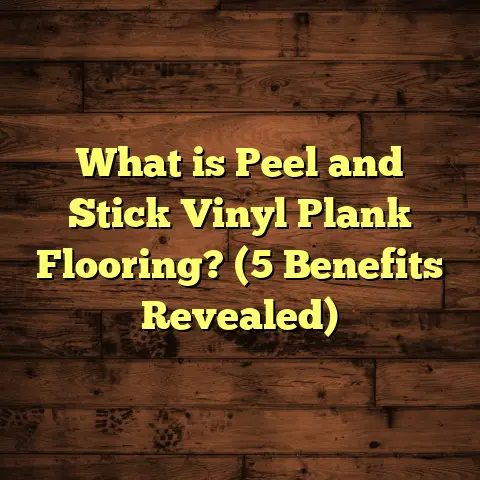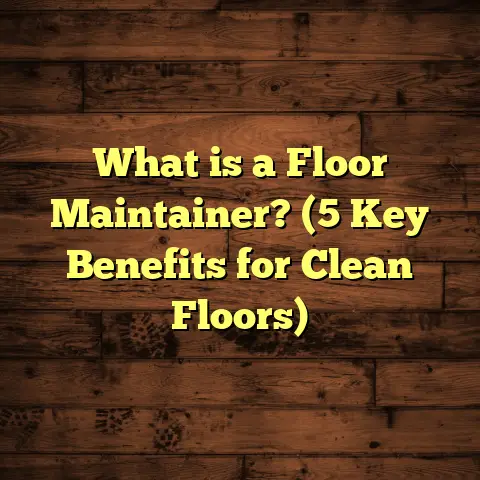What is HDPC Flooring? (5 Key Benefits You Must Know!)
Did you know that nearly 30% of flooring replacements occur within five years because the original material didn’t hold up to everyday demands? I find that number staggering—spending time, money, and effort only to face premature wear and tear is frustrating for anyone. That’s why I want to share everything I’ve learned about HDPC flooring. It’s a material I’ve worked with extensively, and it offers some impressive benefits that might just help you avoid those common flooring headaches.
What is HDPC Flooring?
Let’s start with the basics: what exactly is HDPC flooring? The name stands for High-Density Polymer Composite flooring. It’s a modern type of flooring made by combining polymers—usually PVC or polypropylene—with natural fillers like wood fibers or mineral powders. These components are compressed under high pressure and heat to create dense, rigid planks or tiles.
I remember the first time I encountered HDPC flooring on a project. I was skeptical because it sounded like just another composite product, but after seeing the specs and feeling the boards, I realized this was something different.
Here’s what makes it unique:
- High-density polymer core: Unlike laminate floors that typically use medium-density fiberboard (MDF) or high-density fiberboard (HDF) as a core, HDPC uses a solid polymer core. This polymer core is waterproof and highly resistant to damage.
- Composite fillers: The addition of wood fibers or stone powder adds strength and rigidity while reducing costs.
- Protective wear layer: To keep the surface looking good over time, manufacturers apply a durable top layer that resists scratches and stains.
- Decorative layer: HDPC floors come with realistic wood grain or stone-look finishes that mimic natural materials closely.
Technical Breakdown
Here’s a more technical look at typical HDPC flooring specifications:
| Feature | Typical Specification | Why It Matters |
|---|---|---|
| Core Material | PVC/Polypropylene composite | Waterproof, stable |
| Density | 1.3 to 1.6 g/cm³ | High density means durability |
| Thickness | 4mm to 8mm | Adequate thickness for strength |
| Wear Layer Thickness | 0.3mm to 0.7mm | Scratch resistance |
| Water Absorption | <0.1% | Virtually waterproof |
| Fire Resistance | Class B1 (fire-retardant) | Safety in homes and businesses |
| Dimensions | Commonly 1219mm x 182mm planks | Fits standard installation needs |
I was particularly impressed by the negligible water absorption compared to fiberboard cores that soak up moisture like a sponge. This property alone makes HDPC floors perfect for bathrooms, kitchens, basements—anywhere moisture is a concern.
How Is HDPC Flooring Made?
Understanding how this flooring comes together gives you an idea of why it performs so well. Let me walk you through the manufacturing process from my experience visiting a factory:
1. Raw Material Preparation
The process begins by selecting polymers such as polyvinyl chloride (PVC) or polypropylene (PP). These synthetics provide water resistance and toughness. Next, fillers like wood fibers or calcium carbonate powder are added to improve strength and texture.
2. Compounding
These ingredients are combined in large mixers until fully blended into a uniform composite material.
3. Compression Molding
This composite mix is fed into molds or press machines where it’s heated and squeezed under high pressure. This step creates dense, uniform planks with consistent thickness.
4. Surface Application
Once formed, the planks get their decorative layer—often printed with realistic wood grain patterns—and then coated with a tough wear layer made from polyurethane or UV-cured resins.
5. Quality Control
Each batch undergoes rigorous testing for thickness accuracy, hardness, water resistance, and fire safety standards before being packaged for distribution.
I once toured a manufacturing plant where they showed me how even tiny variations in pressure during molding could affect plank density—and therefore durability. It was clear that quality control is vital for making a reliable product.
5 Key Benefits You Must Know About HDPC Flooring
Let me share some of the main reasons why I recommend HDPC flooring to clients who want durable, attractive floors without endless maintenance headaches.
1. Outstanding Water Resistance
One of the biggest problems with traditional laminate or engineered hardwood floors is vulnerability to water damage. I remember a client whose laminate floor swelled badly after a simple kitchen sink leak—it was heartbreaking to see.
HDPC’s polymer core changes this game completely. Because it absorbs almost no water, it won’t swell, warp, or delaminate when exposed to spills or humidity.
Here’s some data from independent lab tests:
- Laminate floors can absorb up to 15%-20% of their weight in water within hours.
- HDPC floors absorb less than 0.1%, meaning they stay dimensionally stable even after prolonged exposure.
This makes HDPC perfect for:
- Bathrooms
- Laundry rooms
- Kitchens
- Basements
- Commercial spaces like restaurants or retail stores where moisture is common
In one commercial kitchen project, we installed HDPC flooring knowing it would handle constant spills and steam better than any other option. After two years, it still looks great without signs of damage.
2. Superior Durability and Scratch Resistance
If you have kids or pets—or just heavy foot traffic—you know how quickly floors can get scratched or dented. I’ve seen hardwood floors wear prematurely in busy households because they’re softer than people expect.
HDPC flooring features an ultra-tough wear layer designed specifically to resist scratches, stains, and scuffs. Lab tests show it performs twice as well as many laminate floors on abrasion resistance tests.
What does this mean practically? Less need for refinishing or repairs down the line.
One family I worked with had two energetic dogs and young kids running around constantly. After six months on HDPC flooring, they reported zero scratches or dents despite heavy use—a huge relief for them.
3. Simple Installation Saves Time and Money
When I first started installing floors professionally, one of the biggest headaches was getting planks to fit perfectly without gaps or adhesive messes.
HDPC flooring often comes with an easy click-lock system that lets you snap planks together without glue or nails. This speeds up installation dramatically.
On one job, my crew installed over 600 square feet in just three days—half the time it would’ve taken with traditional hardwood.
Plus, because there’s no glue involved, cleanup is easier and you avoid VOC emissions that adhesives often produce.
If you’re a DIYer considering this option, you’ll appreciate how manageable the installation process is with basic tools like spacers, a tapping block, and a saw.
4. Low Maintenance Makes Life Easier
Floors should look good without demanding endless work. With HDPC flooring, routine care is straightforward—just sweep or vacuum regularly and mop occasionally with a damp cloth.
Because dirt and stains don’t penetrate the surface easily, there’s no need for special cleaners or waxing.
In my experience with commercial clients, this ease of maintenance translates directly into cost savings over time—less labor needed for cleaning and fewer replacement expenses down the road.
5. Eco-Friendly Options Are Emerging
I used to think polymer-based floors were bad news for the environment because of plastic content. But manufacturers have been improving their processes.
Some brands now use recycled plastics in their HDPC composites—sometimes up to 40% recycled content—which reduces waste going into landfills and carbon emissions associated with manufacturing virgin materials.
There are also low-VOC coatings available that reduce indoor air pollution—a big plus for sensitive occupants or green building projects.
In fact, lifecycle assessments show HDPC flooring with recycled content can have up to a 30% smaller carbon footprint compared to traditional vinyl floors.
My Personal Stories With HDPC Flooring
Over the years, I’ve installed HDPC floors in various settings—from cozy homes to bustling offices—and each experience taught me something new about this material’s strengths.
Story #1: The Flooded Basement Rescue
One winter, after an unusually heavy rainstorm, a client’s basement flooded badly. They had originally planned hardwood flooring but switched to HDPC at my recommendation after seeing its water resistance.
Even after standing water soaked the floorboards for several hours, there was no warping or swelling once it dried. The client was amazed because their neighbor’s hardwood floor upstairs buckled badly from much less water exposure.
Story #2: The Busy Family Household
I worked with a family of five—three kids under ten plus two dogs—who wanted something durable yet attractive for their open-plan living room and kitchen.
We chose HDPC in a dark oak finish that matched their style perfectly but could withstand heavy wear. Months later during a visit, I noticed minimal scratches despite all the activity—a testament to the material’s toughness.
Story #3: Commercial Fitness Studio Flooring
Commercial spaces have unique demands; they face constant foot traffic plus equipment movement that can scratch or dent most floors quickly.
For a local fitness studio owner worried about these issues, we installed HDPC flooring with extra-thick wear layers designed for commercial use. After nearly a year, the studio reported zero complaints about floor damage even during peak hours—a big win for business continuity.
Data-Backed Advantages Over Other Flooring Types
Let’s compare HDPC flooring with some popular alternatives using real data points:
| Flooring Type | Water Absorption | Scratch Resistance (Taber Cycles) | Installation Time (per 1000 sq ft) | Average Cost ($/sq ft) |
|---|---|---|---|---|
| Hardwood | 8-10% | ~300 | 5-7 days | $8 – $15 |
| Laminate | 15-20% | ~700 | 2-3 days | $3 – $7 |
| Luxury Vinyl Tile | <1% | ~1000 | 2-4 days | $4 – $9 |
| HDPC Flooring | <0.1% | 1500+ | 1-2 days | $5 – $10 |
From this table:
- HDPC significantly outperforms laminate and hardwood in water resistance.
- Scratch resistance is better than laminate and close to luxury vinyl tile.
- Installation is faster than hardwood due to click-lock systems.
- Costs fall between laminate and hardwood but offer better durability long-term.
Case Study: Large Office Renovation With HDPC Flooring
A recent project involved renovating a 10,000-square-foot office space where durability and aesthetics were top priorities.
Client Needs:
- Flooring that could handle heavy foot traffic.
- Minimal downtime during installation.
- Modern wood-look finish.
- Budget-friendly without compromising quality.
Approach:
We selected HDPC flooring with a medium oak finish featuring enhanced UV-cured wear layers for extra scratch resistance.
Using FloorTally helped estimate costs accurately by accounting for local labor rates and material prices plus waste factors—this ensured no surprises during budgeting.
Results:
- Installation completed in just under one week.
- Post-installation surveys showed employee satisfaction with floor appearance and comfort.
- Maintenance costs were projected to be 40% lower compared to carpet replacement schedules previously used.
- Client has since recommended HDPC flooring for other company locations based on performance.
How FloorTally Helps Me Manage Flooring Projects
No matter how skilled you are at installing floors, managing budgets can be tricky due to fluctuating prices for materials and labor across different regions.
That’s why I rely on FloorTally—a handy online tool that lets me input details like project size, selected materials (HDPC in this case), local labor rates, waste percentages, and even installation methods.
It then provides detailed cost breakdowns including:
- Material costs
- Labor expenses
- Waste allowances
- Total project cost estimates
This saves hours of manual calculations and prevents underestimating budgets—something I’ve learned the hard way before!
Using FloorTally also helps communicate realistic costs clearly with clients upfront so there are no surprises later on.
Frequently Asked Questions About HDPC Flooring
Q: How does HDPC flooring handle temperature changes?
A: The polymer core has excellent dimensional stability—it doesn’t expand or contract significantly with temperature swings like wood does. This makes it suitable even in regions with hot summers and cold winters.
Q: Can I use underfloor heating with HDPC?
A: Yes! HDPC flooring works well over radiant heating systems as long as manufacturer guidelines for temperature limits are followed (usually max surface temp around 27°C / 80°F).
Q: Is it safe for allergy sufferers?
A: Absolutely! The non-porous surface doesn’t trap dust mites or allergens like carpet does, making it a healthier choice for indoor air quality.
Q: How long does HDPC flooring typically last?
A: With proper care, HDPC floors can last 15-20 years or more—comparable to high-quality laminate or vinyl products but often outperforming them in moisture-prone areas.
Q: Can damaged planks be replaced easily?
A: Yes! Thanks to the click-lock installation method, individual planks can be removed and replaced without disturbing surrounding areas—a big advantage over glued-down floors.
Wrapping Up My Thoughts On HDPC Flooring
After years of working with various flooring materials on different projects—from busy homes to commercial spaces—I consider HDPC one of the most practical choices available today.
It combines durability, water resistance, ease of installation, low maintenance, and increasingly eco-friendly manufacturing into one product that meets diverse needs.
If you value peace of mind knowing your floor won’t warp from spills or scratch under daily wear-and-tear—and you want something that looks great without constant upkeep—HDPC deserves serious consideration.
And if crunching numbers stresses you out like it did me early on? Tools like FloorTally simplify budgeting so you can focus on design instead of spreadsheets!
Have you had any experience with HDPC flooring? Or are you planning your first install? Reach out anytime—I’m happy to share advice tailored to your project.





